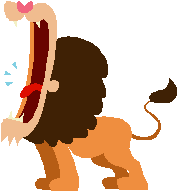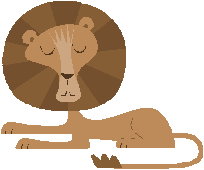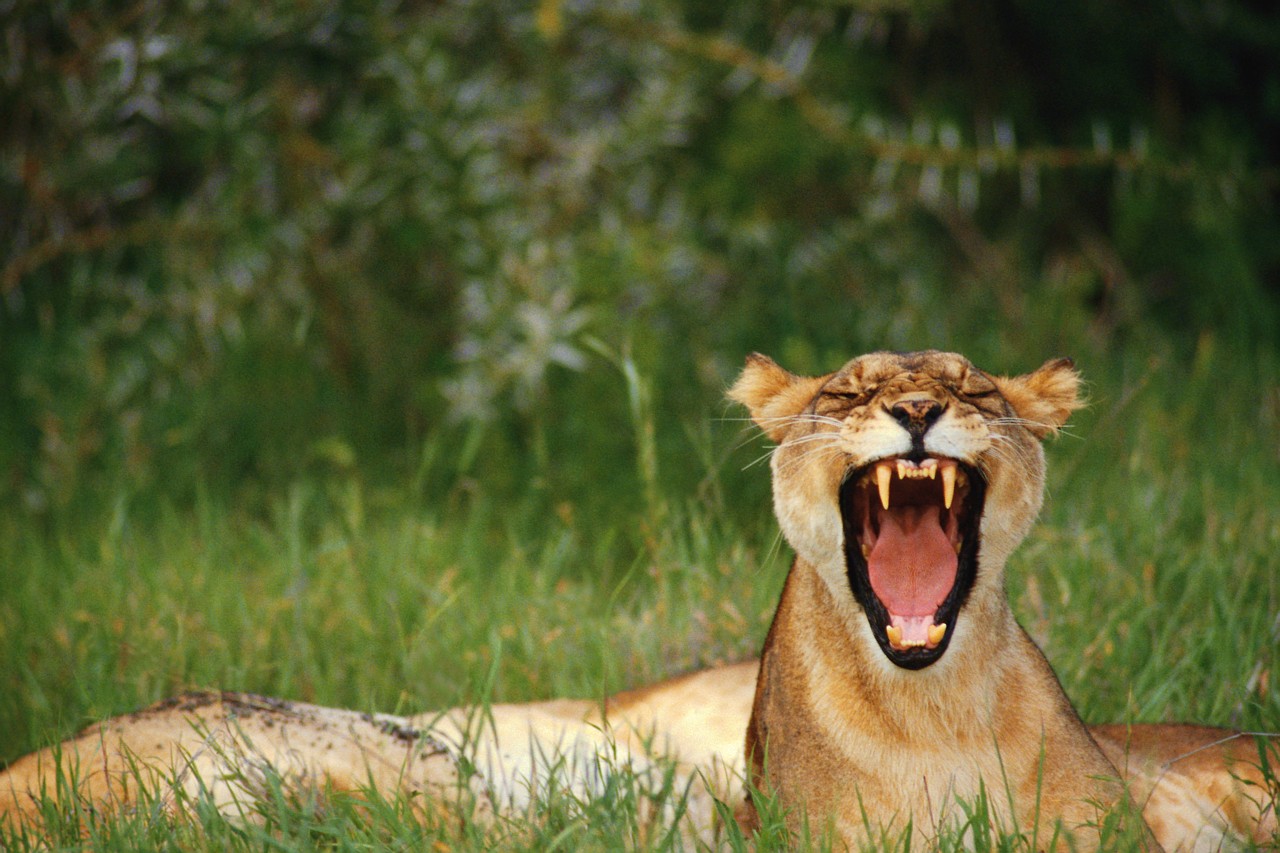![]()
![]()
- Habitat
- Classification and Phylogenetic Tree
- Nutrition
- Interaction and Reproduction
- Little Known Facts
- Bibliography
- About the Author
.![]() ,
,
Panthera leo, better known as the lion, lives primarily in Sub-Saharan Africa and northwest India. The lion can live comfortably in the heat of the African sun and also in the cool temperatures that accompany nighttime due to their endothermic bodies (Encyclopedia of Animals). They prefer to roam the grassy plains of the savannah, but will also make their way into woodland areas (Perth Zoo).
Partial Phylogenetic Tree

![]()
 Jungle Cat Domestic Cat Jaguar
Leopard Tiger Lion
Jungle Cat Domestic Cat Jaguar
Leopard Tiger Lion


Encyclopedia of Animals
Sabertooth Tiger (speculated prehistoric ancestor)
Panthera leo is a carnivore according to its order. This means that it feeds on other organisms. When in it's natural environment, Panthera leo will feed on a variety of animals, both large and small. The range includes anything from rodents to giraffes, and on occasion, humans (see little known facts). However, according to a study done in the Greater Makalali Conservancy, 75% of the diet of Panthera leo consisted of blue wildebeest, warthog, zebra, waterbuck and giraffe. Also, male's account for more predation of larger animals such as giraffe and warthog, while females attack medium-sized prey such as wildebeest and zebra (Greater Makalali Conservancy Study).

Kingdom: Animalia (is an animal)
Phylum: Chordata (is a vertebrate)
Class: Mammalia (gestation period and live birth)
Order: Carnivora (consumes only other organisms)
Family: Felidae (member of the cat family)
![]()
![]()
 Genus
& Species: Panthera leo
Genus
& Species: Panthera leo
To watch an actual pride hunt click here.
Unlike other species of the family Felidae, Panthera leo is a social creature. They live in groups called 'prides' which are made up of 4-12 females, 1-6 males, and the young offspring (Encyclopedia of Animals). Panthera leo reproduces by means of sexual intercourse much like many animals in the class Mammalia. The gestation period for the lioness is around 110 days (Egalitarianism in Female African Lions). Each cycle will produce two to three offspring called cubs. Further, reproduction will occur once every two years for species in the wild, while species in captivity will reproduce every year (Encyclopedia of Animals). One unique feature that is part of reproduction is that the males and females of Panthera leo exhibit sexual dimorphism. The male is larger than the female and has a mane of hair surrounding its head and neck. The mane was thought to be linked to increased protection from predators, but recent studies have proven that the primary purpose of the mane is sexual in nature as females are more attracted to males with darker manes. The darker indicates better nutrition and higher levels of testosterone, while a longer mane is usually a sign of a successful fighter (Sexual Selection, Temperature, and the Lion's Mane).
Panthera leo interacts with other organisms almost always in the form of predation. However, they do have a commensalistic relationship with some organisms that feed off of the pride's "left-overs." Some of these organisms are bacteria that help to decompose the carcass while others include the scavenging birds that wait until the pride is done eating to grab a quick meal.
-
Because the male Panthera leo have such bulky, conspicuous manes, they rarely take part in hunting (Perth Zoo). If they do take part in a group hunt, they will rarely chase prey that has escaped the initial trap (Group Hunting Behaviour in Lions).
-
When hunting, the pride will surround the prey in order to ambush it. Usually this happens by one lioness attacking from the front while the others lie waiting to pounce from the prey's flank.
-
Because of overpopulation in Panthera leo's natural habitat, they are wandering into human villages more often. And while it can not be said whether they are hunting humans for food or other reasons, the number of attacks on humans has gone up in recent years (The Lion's Den).
-
Male Panthera leo always eat first in the pride and may rest for several days after a meal before hunting again (How to Survive a Lion Attack).
-
At birth, all Panthera leo cubs are blind (How to Survive a Lion Attack).
de la Harpe, Roger. Young Male Lion. Mpumalanga. South African Embassy. 28 Mar. 2007 <http://www.saembassymuscat.gov.om/text/gallery/animals.htm>.
Dennis, Nigel J. Male African Lion. Northern Province. South African Embassy. 28 Mar. 2007 <http://www.saembassymuscat.gov.om/text/gallery/animals.htm>.
Dennis, Nigel J. Springbok, Northern Cape. South African Embassy. 28 Mar. 2007 <http://www.saembassymuscat.gov.om/text/gallery/animals.htm>.
Druce, Dave, Sophie Greatwood, Jonathan Braak, Audrey Delsink, Ross Kettles, Luke Hunter, Heleen Genis, and Rob Slotow. "Prey Selection by a Reintroduced Lion Population in the Greater Makalali Conservancy, South Africa." African Zoology 39 (2004). Academic Search Elite. EBSCO. 15 Apr. 2007. Keyword: lion predation.
Lion Attack II. 2007. YouTube. 25 Apr. 2007 <http://www.youtube.com/watch?v=viK4IqTc_oM&mode=related&search=>.
"Lion." Encyclopedia of Animals. Academic Search Elite. EBSCO Animals. 15 Apr. 2007. Keyword: Lion.
Minarcek, Andrea. "The Lion's Den." National Geographic 8 (2006): 55. Academic Search Elite. EBSCO. 20 Apr. 2007.
Packer, Craig, Anne E. Pusey, and Lynn E. Eberly. "Egalitarianism in Female African Lions." Science 293 (2001): 690. Academic Search Elite. EBSCO. 12 Apr. 2007. Keyword: Panthera leo reproduction.
"Panthera Leo." Perth Zoo. 28 Mar. 2007 <http://www.perthzoo.wa.gov.au/Animals--Plants/Africa/African-Savannah/Lion/>.
Smith, Mike. "How to Survive a Lion Attack." National Geographic Kids 345 (2004): 30. Academic Search Elite. EBSCO. 8 Apr. 2007. Keyword: lion attack.
West, Peyton M., and Craig Packer. "Sexual Selection, Temperature, and the Lion's Mane." Science 297 (2002). Academic Search Elite. EBSCO. 26 Apr. 2007. Keyword: lion reproduction.
Hi everyone, my name is Luke Zurbriggen. I am the creator of this webpage and am currently a sophomore at UW-LaCrosse. This webpage was created as a project for Bio 203 - Organismal Biology. I chose Panthera leo as my organism because I have always been fascinated with Lions. Any questions or comments about the webpage can be directed through my UW email account: zurbrigg.luke@students.uwlax.edu. Hope you all enjoyed the page.







